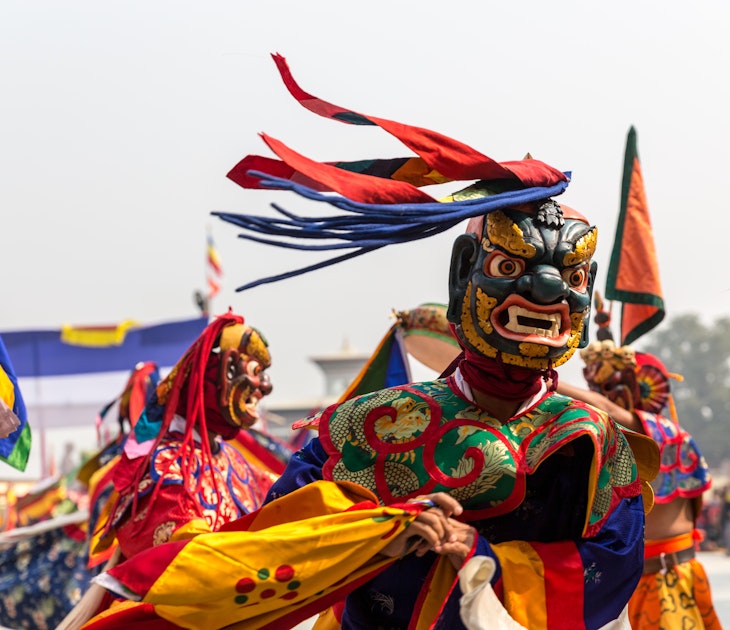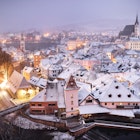
What happened in Vegas: A history tour of Sin City
Mar 20, 2018 • 6 min read

Close up view of dusty, old Las Vegas neon signs in a state of disrepair in a junkyard
Las Vegas has a reputation for tearing down the old in favor of the shiny and new. But, occasional hotel tower implosions aside, it’s not a place lacking in history as some dour detractors like to say.
Vegas didn’t just pop into existence in the middle of the Mojave Desert when neon lights were invented. In fact, its history stretches back millennia, and much of it can be explored by today’s travelers.

An early destination
Las Vegas is a natural oasis, with its Spanish name meaning 'the meadows.' But 20,000 years ago, the region was more than a watering hole, it was a verdant swath of Pleistocene epoch wetlands filled with lions, camels and now-extinct megafauna like mammoths. Before the local climate dried out, these creatures left their bones in what is now Tule Springs Fossil Beds National Monument on the northern edge of the metropolitan area.
Archaic peoples eventually lived nearby at what is now the vast Desert National Wildlife Refuge, followed by members of the Southern Paiute tribe in recent centuries. The preserve’s visitors center and trail system feature educational displays honoring these cultures.

Ancestral Puebloans, usually associated with the adjacent states of Utah and Arizona, once built their westernmost settlements just 70 miles north of modern Las Vegas under what is now an arm of Lake Mead. Their long-abandoned cliff dwellings were relocated and recreated in the 1930s at the interesting Lost City Museum. In addition, much more of the region’s history is on display at the impressive Nevada State Museum near Downtown Las Vegas.
Pioneer days
While the land around Las Vegas was once part of colonial Spain, it was barely visited by Europeans until the early 1800s, when it became part of the rambling Old Spanish Trail that once linked Santa Fe to the missions of Southern California. Later, pioneers and homesteaders followed this dusty trail and founded permanent stops, like the vintage structures in majestic Red Rock Canyon at Spring Mountain Ranch State Park. It features a gorgeous, antique-filled house that was once owned by German movie star Vera Krupp and then the fabulously wealthy Howard Hughes. It’s open daily for touring and meandering about its lush grounds beneath soaring sandstone cliffs.

Also important to Las Vegas’ early days is Old Las Vegas Mormon Fort State Park in Downtown, a replica adobe redoubt built by Mormon missionaries in 1855; Southern Nevada has long been home to a thriving community of the American-born faith.
For a glimpse into how Las Vegas looked once the railroad arrived, the permanent Boomtown 1905 exhibit at the Springs Preserve has era-accurate versions of a bank, saloon, train station, hotel, cottages, and more. And the recently renovated Golden Gate Hotel at the corner of Main and Fremont has been open for lodging, eating, drinking, and gambling since 1906.
Finally, for a kitschy look back on pioneer times, Bonnie Springs in Red Rock Canyon is an Old West recreation with some creative license.
The neon cowboy era
Las Vegas never became infamous as a Wild West stomping ground for frontiersmen, prospectors, or gunslingers the way Tombstone, Ariz., or even Virginia City (near Reno) did. But foreshadowing its later ‘sinful’ reputation, Vegas was long a place open to less conservative lifestyle choices, such as divorce.
While severing matrimonial ties was illegal or difficult to obtain in most of the US in the early 20th century, Nevada only required a six-week residency. This led to Las Vegas becoming a destination for quick divorces; Hollywood glitterati and the rich stayed at what is now Floyd Lamb Park at Tule Springs, waiting to file papers. Now the former dude ranch is an expansive and lovely city greenspace filled with preserved ranch buildings.

During this time, Las Vegas also became increasingly electrified, especially when monumental Hoover Dam was completed in 1936, converting the mighty Colorado River’s flow into power. To this day, it’s a wonder of the modern world, and is filled with Art Deco flourishes throughout. It’s a must-do tour.
After World War II, Las Vegas became known for a different kind of energy: atomic. Beginning in 1951, nuclear weapons were detonated a hundred miles north of town by the U.S. government, sometimes with mushroom clouds visible in the distance. This local facet of the Cold War is documented at the National Atomic Testing Museum near the Strip. Two popular dining and drinking establishments born in those explosive days still thrive. Atomic Liquors on East Fremont Street is a vibrant spot for craft cocktails, and Bob Taylor’s Ranch House is a western-themed, open-grill steakhouse filled with the tantalizing aroma of mesquite charcoal smoke.
'Rat Pack' Vegas nights
After its cowboy days, Las Vegas became glamorous when legendary entertainers like Frank Sinatra, Dean Martin, and Sammy Davis Jr started holding musical court in showrooms on the Strip in the ‘50s. (Elvis would arrive in full glory later, in 1969.) Many of the hotels frequented by the Rat Pack – as the group is known – are long gone. However, the Tropicana, opened in 1957, is still booking rooms and dealing cards.
The Golden Steer, a cozy steakhouse that was a favorite of the performers, opened in 1958 and still draws nostalgic gourmands. And while Caesars Palace opened a bit later in 1966, it has retained its Rat Pack glory while staying contemporary.

For a pair of dining options that keep the jazzy ‘50s vibe alive, the Bootlegger Bistro and the Italian American Club of Las Vegas both feature nightly live music, including tributes to Ol’ Blue Eyes and his compadres.
Of course, you can’t bring up these scintillating mid-century Vegas days without addressing their dark side: the mafia. The Mob Museum is a non-congratulatory, eye-opening, and well-curated view of organized crime.
The family-friendly, kitschy era
Once Las Vegas became a more well-known vacation destination, cowboy times and Rat Pack glam took backseat to a new crowd: families with children. The first foray into welcoming kids to town (a tiny bit) was Circus Circus, with its big top theme, which opened in 1968. It’s somewhat faded arcade diversions still work.
The next big leap for families came in 1989 with the Mirage and its faux outdoor volcano. The early ‘90s brought fantasy medieval times to the Strip with the turreted Excalibur (which still has its knights-on-horseback dinner Tournament of Kings extravaganza). And the ancient Egyptian theme of the Luxor and the pirate motif of Treasure Island are now dim remnants of their heydays, but still offer photo backdrops.

What else remains of those exuberant family-themed days? The animatronic Fall of Atlantis show in the Forum Shops has been interpreting a myth since 1992, and the illuminated canopy of the Fremont Street Experience has been flashing in the evening since 1995.
Heading into the late ‘90s and the 2000s, hotels pivoted to big stage shows like Cirque du Soleil, nightclubs, and haute cuisine restaurants, leaving some of the classic patina of Sin City in the dust. But glimpses of times gone by are still out there to discover.
Explore related stories

Architecture
The ultimate guide to Tibetan Buddhist monasteries: exploring gompas in the HimalayasNov 22, 2024 • 7 min read

 Festivals & EventsChristmas dinners around the world: choose your favorite festive dishes
Festivals & EventsChristmas dinners around the world: choose your favorite festive dishesNov 22, 2024 • 5 min read


 BeachesThese 5 day trips from Sydney will show you the splendors of New South Wales
BeachesThese 5 day trips from Sydney will show you the splendors of New South WalesNov 22, 2024 • 7 min read

 Destination PracticalitiesDo you need a visa to visit Thailand? Here’s everything to know
Destination PracticalitiesDo you need a visa to visit Thailand? Here’s everything to knowNov 22, 2024 • 8 min read










